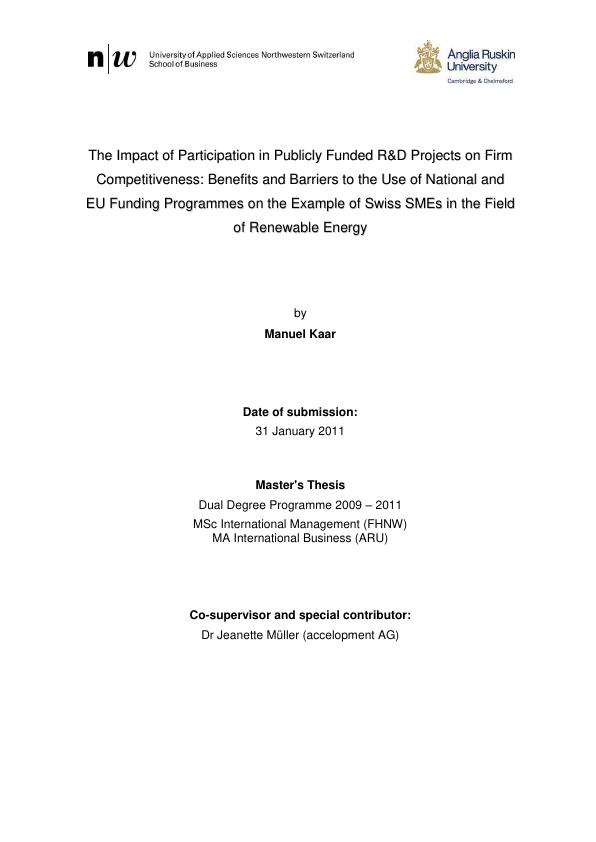This thesis studies the involvement of small and medium-sized enterprises (SMEs) in publicly funded research and development (R&D) projects. SMEs represent 99% of all companies in Europe and are important drivers of innovation, yet many lack the necessary resources to engage in formal research activities. Providing these firms with the possibility to make use of public funding programmes for R&D projects therefore constitutes a way of stimulating them to innovate. Reviews of such programmes, however, show that SME participation is frequently lower than desired by policy makers. This raises the question of the benefits SMEs can gain from such projects and the barriers that negatively influence their ability to participate. The author hypothesises that taking part in publicly funded R&D projects can positively influence an SME’s competitiveness through a specific set of advantages gained from participation. The second hypothesis is that companies with previous experience in such projects evaluate their participation positively. Finally, the author puts forward that a number of specific barriers limit SMEs’ ability to participate. The hypotheses were tested by means of an online survey among Swiss SMEs in the field of renewable energy, as well as interviews with representatives of national and EU funding bodies. The results support all three hypotheses and confirm the importance of the public measures. Participation in publicly funded R&D projects can indeed have positive impacts on an SME’s competitiveness. Also, companies tend to evaluate their participation positively. SMEs with previous experience in such projects were well-informed about the specifics of a participation prior to filing an application, whereas a substantial lack of information exists on the part of companies without previous experience. This study adds to the existing pool of literature on SME competitiveness, and through its narrow focus addresses a very specific area where little research has been conducted to date. As such, the thesis is of relevance to the business, research, and political communities.
Inhaltsverzeichnis (Table of Contents)
- Abstract
- Statutory declaration
- Acknowledgements
- Table of contents
- List of tables and figures
- List of abbreviations
- Introduction
- Review of selected theories on firm competitiveness
- General aspects
- Industrial organisation view
- Resource-based view of the firm
- Dynamic capabilities
- Knowledge-based view of the firm
- R&D funding in Switzerland
- General aspects
- Switzerland as a research location
- SME specific issues
- Relevant Swiss research promoting institutions
- Funding programmes of the SFOE
- Hydropower research
- Biomass and Wood energy research
- Photovoltaics research
- Solar heat and heat storage research
- Wind energy research
- Heat pumping technologies, cogeneration, refrigeration research
- Indirect support of geothermal energy
- Funding by the CTI
- R&D projects
- The CTI “Innovationsscheck”
- Feasibility studies
- R&D funding at the European level
- General aspects
- Europe as a research location
- Relevant EU research promoting instruments
- SME specific issues
- 7th Framework Programme for Research and Technological Development
- FP7-Cooperation-ENERGY
- FP7-Cooperation-ENVIRONMENT
- FP7-Capacities-Research for the benefit of SMEs
- EUREKA
- EUREKA Eurostars
Zielsetzung und Themenschwerpunkte (Objectives and Key Themes)
This thesis investigates the involvement of small and medium-sized enterprises (SMEs) in publicly funded research and development (R&D) projects. It examines the benefits SMEs can gain from participation in such projects and the barriers that hinder their involvement. The study explores the potential impact of R&D project participation on SME competitiveness and evaluates the experiences of companies with previous involvement in these initiatives. Key themes of the thesis include: * **The role of SMEs in innovation and the challenges they face in engaging in R&D activities.** * **The benefits and barriers associated with SME participation in publicly funded R&D projects.** * **The impact of R&D project participation on SME competitiveness.** * **The experiences and perspectives of SMEs with prior involvement in such projects.** * **The effectiveness of public funding programs in stimulating SME innovation.**Zusammenfassung der Kapitel (Chapter Summaries)
- Introduction: This chapter provides an overview of the research topic, outlining the research questions and objectives. It also highlights the relevance and significance of the study.
- Review of selected theories on firm competitiveness: This chapter explores different theoretical perspectives on firm competitiveness, including industrial organization, resource-based view, dynamic capabilities, and knowledge-based view. It examines how these theories relate to the study's focus on SME participation in publicly funded R&D projects.
- R&D funding in Switzerland: This chapter provides a comprehensive overview of R&D funding schemes in Switzerland, focusing on SME-specific issues and relevant research promoting institutions. It explores various funding programs offered by the Swiss Federal Office of Energy (SFOE) and the Commission for Technology and Innovation (CTI).
- R&D funding at the European level: This chapter presents an overview of R&D funding programs at the European level, focusing on the 7th Framework Programme for Research and Technological Development (FP7). It explores specific FP7 programs relevant to SMEs, including FP7-Cooperation-ENERGY, FP7-Cooperation-ENVIRONMENT, and FP7-Capacities-Research for the benefit of SMEs. The chapter also discusses the EUREKA and EUREKA Eurostars programs.
Schlüsselwörter (Keywords)
This thesis focuses on the competitiveness of SMEs in the context of publicly funded R&D projects. Key themes include: SME innovation, R&D participation, public funding programs, barriers to innovation, competitiveness, and the renewable energy sector.- Quote paper
- MSc, MA Manuel Kaar (Author), Dr. Jeanette Müller (Author), 2011, Benefits and barriers of an enterprise's participation in publicly funded R&D projects. The example of Swiss enterprises in the field of renewable energy, Munich, GRIN Verlag, https://www.grin.com/document/169649



